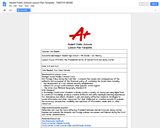
Students will research and debate the presidential terms of Gerald Ford and Jimmy Carter.
- Subject:
- History
- U.S. History
- Material Type:
- Lesson
- Provider:
- Michigan Virtual
- Author:
- Tim Beebe
- Date Added:
- 04/26/2017

Students will research and debate the presidential terms of Gerald Ford and Jimmy Carter.
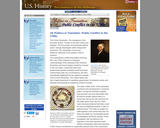
The French Revolution. The emergence of the two-party system. Threats of war with France and England. The first transfer of Presidential political power. George Washington called "debauched" and worse. The clampdown of personal freedoms. Welcome to the political 1790s in America.
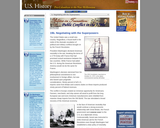
The United States was a small new country. Regardless, it found itself in the midst of the dramatic escalation of political and military conflicts brought on by the French Revolution.
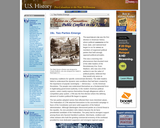
The election of 1796 was the first election in American history where political candidates at the local, state, and national level began to run for office as members of organized political parties that held strongly opposed political principles.
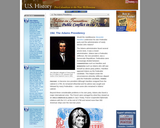
The Adams administration faced several severe tests. It was a mixed administration. Adams was a Federalist. Jefferson, the vice-president, was a Democratic-Republican. Federalists were increasingly divided between conservatives such as Hamilton and moderates such as Adams who still saw himself as above party politics.
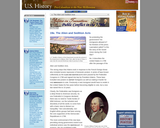
No protesting the government? No immigrants allowed in? No freedom of the press. Lawmakers jailed? Is this the story of the Soviet Union during the Cold War? No. It describes the United States in 1798 after the passage of the Alien and Sedition Acts.
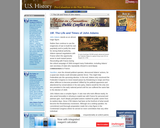
Rather than continue to use the exigencies of war to build his own popularity and to justify the need for strong federal authority, Adams opened negotiations with France when the opportunity arose to work toward peace. Reconciling with France during the critical campaign of 1800 enraged many Federalists, including Adams' own secretary of state who repeatedly refused to send peace commissioners to France.
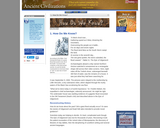
How do we know about the past? Did a giant flood actually occur? Or were the stories of Gilgamesh and Noah folk tales intended to provide moral guidance?
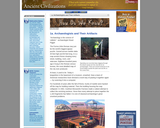
This section describes the history and practice of archaeology
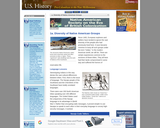
Since 1492, European explorers and settlers have tended to ignore the vast diversity of the people who had previously lived here. It soon became common to lump all such groups under the term "Indian." In the modern American world, we still do. There are certain experiences common to the survivors of these tribes. They all have had their lands compromised in some way and suffered the horrors of reservation life.

When the British set foot on the North American continent at Jamestown, they encountered the Powhatan Indians. The Pequots and Narragansetts lived in New England as the Pilgrims and Puritans established a new home. William Penn encountered the Leni Lenape natives while settling "Penn's Woods." Although these tribes have great differences, they are linked linguistically. All of these tribes (or nations) speak an Algonquin language. These Algonkian (or Algonquian) groups were the first the English would encounter as these early settlements began to flourish.

Humans are curious creatures, always wondering what lies beyond the horizon. Lewis and Clark did not describe themselves as geographers, but they might well have. Geography is the study of the surface of the earth. It is about people and places. It is about the physical character of a country, its climates and landscapes, and its biological environment.
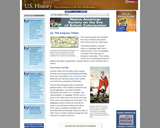
Technically speaking, "Iroquois" refers to a language rather than a particular tribe. In fact, the Iroquois consisted of five tribes prior to European colonization. Their society serves as an outstanding example of political and military organization, complex lifestyle, and an elevated role of women.

The harsh public antagonism of the 1790s largely came to an end with the victory of the Democratic- Republicans in the 1800 election. "The Revolution of 1800," as Jefferson described his party's successful election many years later, was "as real a revolution in the principles of our government as that of 1776 was in its form."
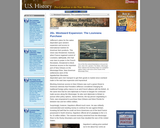
Jefferson's plans for the nation depended upon western expansion and access to international markets for American farm products. This vision was threatened, however, when France regained control of Louisiana. Napoleon, who had now risen to power in the French Revolution, threatened to block American access to the important port of New Orleans on the Mississippi River. New American settlements west of the Appalachian Mountains depended upon river transport to get their goods to market since overland trade to the east was expensive and impractical.
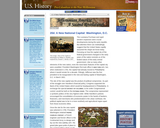
The Louisiana Purchase and rapid western expansion were crucial developments during the early republic. But attention there can misleadingly suggest that the United States rapidly assumed the shape we know today. Focusing on how the capital city of the federal government changed in the early years of the nation reminds us of the limited nature of the early central government. Like so many other elements of the new nation, even the most basic features of the capital city were unsettled. President Washington first took office in New York City, but, when reelected in 1792, the capital had already moved to Philadelphia where it would remain for a decade. Fittingly, Jefferson was the first president to be inaugurated in the new and lasting capital of Washington, D.C. in March 1801.
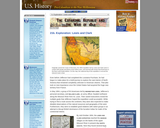
In May 1804, a group of 50 Americans led by Meriwether Lewis, Jefferson's personal secretary, and William Clark, an army officer, headed northwest along the Missouri River from St. Louis. Their varied instructions reveal the multiple goals that Jefferson hoped the expedition could accomplish. While trying to find a route across the continent, they were also expected to make detailed observations of the natural resources and geography of the west. Furthermore, they were to establish good relations with native groups in an attempt to disrupt British dominance of the lucrative Indian fur trade of the continental interior.
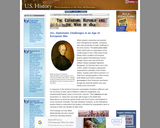
While western movement and policies were reshaping the republic, European wars also presented a major challenge to the new country. The Napoleonic Wars (1802-1815) were a continuation of the conflict begun in the 1790s when Great Britain lead a coalition of European powers against Revolutionary France, though France was now led by the brilliant military strategist Napoleon Bonaparte. As had also been true in the 1790s, neither European superpower respected the neutrality of the United States. Instead, both tried to prevent U.S. ships from carrying goods to their enemy. Both Britain and France imposed blockades to limit American merchants, though the dominant British navy was clearly more successful.
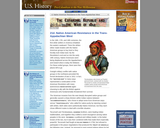
In the 16th, 17th, and 18th centuries, the first white settlers in America inhabited the eastern seaboard. There the whites either made treaties with the Native American groups to buy land or they forcibly took Indian land. By the Revolution's end and on into the early 19th century, Native Americans were being displaced across the Appalachians and toward what is today the Midwest. For these exiled groups, there were few places left to go.
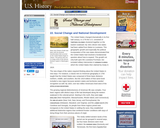
The United States changed dramatically in its first half century. In 1776 the U.S. consisted of thirteen colonies clustered together on the eastern seaboard. By 1821 eleven new states had been added from Maine to Louisiana. This geographic growth and especially the political incorporation of the new states demonstrated that the United States had resolved a fundamental question about how to expand. This growth not only built upon the Louisiana Purchase, but included military intervention in Spanish Florida which the United States then claimed by treaty in 1819.